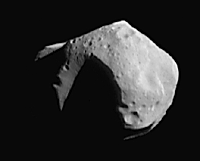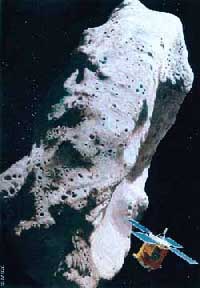A picture by artist Pat Rawling of the NEAR spacecraft in front of Eros.
Click on image for full size
Courtesy of Johns Hopkins University Applied Physics Laboratory
Nearly There...
News story originally written on February 11, 1998
Thanks to a recent Earth swing-by, the NEAR spacecraft is on its final approach. NEAR stands for Near Earth Asteroid Rendezvous. This is the spacecraft that flew by asteroid
Mathilde in June 1997, past Earth in January 1998 and is now on its way to
asteroid Eros, the final mission target!
NEAR is scheduled to arrive at Eros in December 1998. It will orbit the asteroid at an altitude of 600 miles. The spacecraft will descend to 200 miles altitude by February and will continue to lessen its altitude during a year long study of the 25 mile long asteroid. Scientists hope to map the surface of the asteroid as well as determine its composition and chemical characteristics. On February 6, 2000, the mission will come to its climax as the NEAR spacecraft decends onto the asteroid (hopefully in a controlled fashion!).
This is an unique and exciting mission - stay tuned for more details!
You might also be interested in:

On June 27, 1997, the NEAR spacecraft passed within 1200 km of the asteroid Mathilde. NEAR stands for Near Earth Asteroid Rendevous. It is one of NASA's Discovery missions, a series of small-scale spacecraft
...more
It was another exciting and frustrating year for the space science program. It seemed that every step forward led to one backwards. Either way, NASA led the way to a great century of discovery. Unfortunately,
...more
The Space Shuttle Discovery lifted off from Kennedy Space Center at 2:19 p.m. EST, October 29th. The sky was clear and the weather was great as Discovery took 8 1/2 minutes to reach orbit for the Unitied
...more
A moon was discovered orbiting the asteroid, Eugenia. This is only the second time in history that a satellite has been seen circling an asteroid. A special mirror allowed scientists to find the moon
...more
Will Russia ever put the service module for the International Space Station in space? NASA officials are demanding an answer from the Russian government. The necessary service module is currently waiting
...more
During a period of about two days in early May, 1998, the ACE spacecraft was immersed in plasma associated with a coronal mass ejection (CME). The SWICS instrument on ACE, which determines unambiguously
...more
J.S. Maini of the Canadian Forest Service has referred to forests as the "heart and lungs of the world." Forests reduce soil erosion, maintain water quality, contribute to atmospheric humidity and cloud
...more















